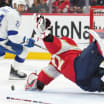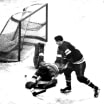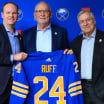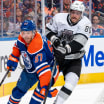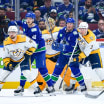Sharks need Brent Burns to be playoff force again
Defenseman endured late-season goal-scoring slump
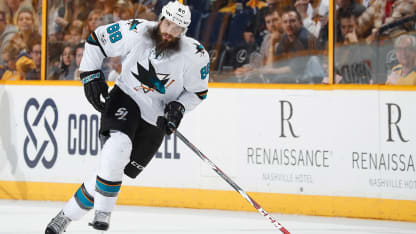
© John Russell/Getty Images
When those tech stocks are performing well, the NASDAQ composite climbs to record highs and Silicon Valley smiles.
Similarly, when Burns is on his game, getting his shot through traffic, scoring goals or creating mayhem, the Sharks generally thrive as well.
Teams caught a look at that a year ago when Burns was the absolute engine that drove the Sharks to the Stanley Cup Final.
From October through February, Burns and the Sharks were prospering again. Burns was not only being talked about as a heavy favorite for the Norris Trophy, given to the NHL's top defenseman, but seemed to be a prime candidate for the Hart Trophy, awarded to the League's most valueble player.
On Feb. 18, Burns scored his 26th and 27th goals of the season in a 4-1 win against the Arizona Coyotes and the Sharks led the Edmonton Oilers by four points for first place in the Pacific Division.
But when Burns' production fell off, the Sharks struggled too, almost in lockstep. In March, he scored once and was minus-7 for the month. Following the two-goal game, he didn't score for 16 games before his goal in overtime defeated the New York Rangers on March 28. (He scored one more the rest of the season to finish with 29.)
During that five-week funk, the Sharks fell out of first place. They finished the season 46-29-7, in third place in the Pacific Division.
Late last month, Burns engaged in a long stream of thought sitting in his stall in the dressing room at Scotiabank Saddledome, looking for answers and finally suggesting a novel one for the Sharks.
"Who knows?" he said. "Got to see a witch doctor or something."
Even if his numbers were down, his peers were still talking Burns up. They know that the beard is ready for the playoffs and Burns' game will be too. Burns was a dominant force in the 2016 postseason with 24 points (seven goals, 17 assists) in 24 games, finishing second in the NHL playoff scoring race to teammate Logan Couture and even ahead of offensively gifted teammates Joe Pavelski and Joe Thornton.
Calgary Flames captain Mark Giordano said Burns was his usual difference-making self in the March 31 victory against the Sharks, more than a handful to handle. Burns is more than capable of duplicating his dominant playoff performance from 2016, starting when the Sharks play Game 1 against the Edmonton Oilers in the Western Conference First Round on Wednesday (10 p.m. ET; SN, TVA Sports, USA).
"The numbers are one thing but when you play against a guy, you really get a feel," Giordano said. "When we played them [last month], I didn't see a difference in his game. I thought he was actually better.
"I thought we had to be more aware of him because they were pressing. You could tell he was pushing the pace. He was pretty good in that game. It's just a matter of time with guys like that."
In other words, Burns is too good to stay this quiet for this long.
The fact that Burns was among the NHL's scoring leaders for most of the season was an extraordinary achievement, something that harkens back to another era.
"It is quite remarkable especially in this day and age because of team structure, defensively," said Nashville Predators assistant coach and Hall of Famer Phil Housley, the fourth-highest scoring defenseman in NHL history (1,232 points).
"It's rare that a defenseman could be in the mix for a scoring title and it's a credit to him. Just the way he can skate, his shot and his ability and knack offensively to jump in holes is amazing."
Not only did Burns hit another level of excellence at 32, scoring 76 points (29 goals, 47 assists), but he had 75 points (27 goals, 48 assists) in 2015-16.
San Jose Sharks general manager Doug Wilson, a Norris Trophy winner in 1982 with the Chicago Blackhawks, played against Bobby Orr and with him near the end of Orr's career, a brief turn with Chicago. The GM said Burns and his size (6-foot-5, 230 pounds) could have been a fit in any era. Wilson scored 39 goals in 1981-82, not long before Edmonton Oilers defenseman Paul Coffey scored 40 in 1983-84 and 48 in 1985-86.
"A lot of offense is being created from the backend, so he just fits exactly where the game is at today and I think you're seeing some offensive numbers come again," Wilson said. "You're seeing younger players in the League to be able to come and do things that maybe weren't as possible in recent years."
In November, Wilson signed Burns to an eight-year contract. It becomes effective in July and is worth $64 million, according to ESPN. Burns was a Norris Trophy finalist in 2016, finishing behind Drew Doughty of the Los Angeles Kings and Erik Karlsson of the Ottawa Senators.
"That's one of the reasons he was so important and why we gave him the contract that we did," Wilson said. "Because there's not many players like that, the Doughtys, the Karlssons. He is much more than just the offensive numbers.
"You can still put up numbers but you can be a reliable player defensively."
Burns came from what is widely considered one of the best NHL Draft classes, 2003. The Minnesota Wild took Burns in the first round (No. 20), one pick behind center Ryan Getzlaf, who went to the then-Mighty Ducks of Anaheim.
The Wild didn't draft Burns with the intention of making him a defenseman. That idea would later come from the creative mind of then-Wild coach Jacques Lemaire. The player personnel sage for the Wild in those days was Tommy Thompson, who worked for then-general manager Doug Risebrough.
"Our scouts said to me, 'You should follow Burns,'" Thompson said. "This was in March. I followed him three games in a row and the [scout] contacted me and said, 'What do you think?' I told him, 'I don't agree with your assessment of the second round.'
"He started to give me a sales pitch for Burns and I said, 'I think he can get into the first round.' When you see a guy that big who can skate like that and handle the puck, he was coming on like gangbusters."
Burns has a larger-than-life personality, so the focus for much of his career has often been on his wild beard and offbeat persona, which almost overshadow the player on the ice. The narrative started to tilt last season and adjusted even more so this season with his earlier MVP push.
Risebrough, for one, welcomed the broader recognition of Burns' ability and attention to detail.
"In this business, I always feel like substance is more important than spin and Brent is more about substance than spin," Risebrough said. "He's a guy that has worked really hard at being a player. He's got a great passion for the game. It's still a game to him and it's not a business.
"Now all those things are getting him all this personal attention. Never mind his look."
The last defenseman to score 30 goals in the NHL was Mike Green of the Washington Capitals in 2008-09. Housley scored 31 with the Buffalo Sabres in 1983-84.
"One thing he does really well is he gets his shots through from the point whether he's changing his angle and he makes that quick wrister," Housley said. "People don't realize how hard that quick wrist shot is. Guys are getting in shot lanes and doing a terrific job of creating that first layer and then you've got the second layer where defensemen are fronting pucks in front of the net.
"It's amazing that he does that so well. It's a great lesson for all the young kids out there. Your shot doesn't always have to be a slap shot."
Kevin Hatcher had the highest season goal total by a defenseman in the 1990s with 34 for the Washington Capitals in 1992-93. When David Poile, now the general manager of the Nashville Predators, was the GM in Washington, he had potent defensemen in Hatcher, Al Iafrate and Sylvain Cote.
Poile and current Capitals coach Barry Trotz each compared Burns to Iafrate.
"When [Iafrate] was 100 percent, he was that dynamic player like Burns is," Poile said. "That's the guy that [he] reminds me [of] the most, of a straight comparison."
Confident and freewheeling, to be sure.
"He's got the green light all the time," Poile said. "There is no red light in his game."




